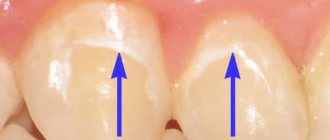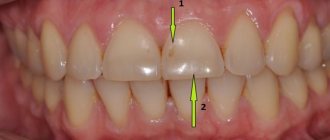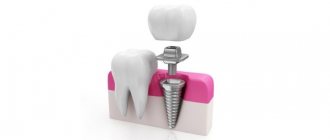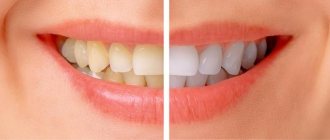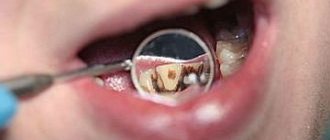The adverse effects of external factors lead to a weakening of the crystal lattice of tooth enamel and the formation of microcracks on its surface.
As a result, increased sensitivity (hyperesthesia) of the teeth develops, their color changes, and the risk of caries increases. To coat teeth with enamel, dentists use pharmaceutical gels and varnishes that contain various mineral compounds.
In what cases is it recommended to coat teeth with varnish?
The protective properties of enamel are due to the strength of the bonds in its crystal lattice formed by calcium mineral compounds (hydroxyapatites).
In addition to performing a barrier function, this layer of crowns ensures the transparency and shine of healthy teeth when exposed to sunlight.
If the chemical bonds in hydroxyapatite prisms are weakened, mineral substances are gradually washed out from the hard tissues of the tooth (demineralization) and the enamel becomes thinner. At the same time, the affected tooth loses its shine and becomes darker.
After the completion of the physiological processes of mineralization, active proteins of the enamel matrix and stem cells disappear in the hard tissues of teeth. The absence of these structural components explains the impossibility of producing a replacement mineral coating in mature tooth enamel and the formation of new hydroxyapatite prisms in the crystal lattice.
At the initial stages of demineralization of hard tooth tissues, it is possible to slow down the rate of development of destructive processes and partially restore the damaged enamel surface artificially. For this purpose, the following treatment methods have been developed in dentistry:
- Coating the surface of teeth with gels and varnishes containing simple fluorides (NaF).
- Deep fluoridation is the saturation of hard tooth tissues with mineral compounds by treating damaged surfaces with preparations that contain complex fluorine compounds (CaF2). Thanks to this, the therapeutic effect in comparison with the use of fluoride-containing varnishes is enhanced 100 times.
- Physiotherapeutic treatment – strengthening the structure of tooth enamel by introducing fluoride and calcium ions into it using low-frequency electric current discharges (electrophoresis).
- Enamel implantation is an innovative technique developed by American scientists. Only this treatment method allows you to restore fairly large damaged areas of tooth enamel. Along with the therapeutic effect, after enamel implantation, the appearance of teeth improves - the use of this technology helps to lighten their surface by up to 10 tones.
Fluorine-containing composition can only be used as prescribed by a doctor. Indications for coating the surface of teeth with varnish are as follows:
- treatment of hyperesthesia;
- protecting teeth from the aggressive effects of acids, for example, if there is a history of gastroesophageal reflux;
- temporary anesthesia of dental units ground before installing artificial crowns;
- protection and restoration of the enamel surface after removal of braces or cosmetic teeth whitening;
- slowing down the processes of destruction in the hard tissues of the tooth in the presence of the first signs of caries formation (stain stage). The most effective results in reducing the caries process are observed when treating baby teeth.
Recent developments in the pharmaceutical industry have led to the creation of fluoride varnish, which not only helps strengthen tooth enamel, but also acts as a paint. After applying such products, a short-term cosmetic effect is achieved - the surface of the teeth is instantly evened out in color, lightened by several tones, and the painted edges of the fillings are masked.
Yellow teeth: reasons
There are several reasons why stains appear on teeth or why teeth are yellow instead of white.
- Food and drink.
The most popular products that can affect the change in the color of tooth enamel are coffee, tea, bright and dark juices (pomegranate, cranberry). Coloring foods include ice cream and chocolate; sauces and seasonings that have yellow or brown tints; vegetables and fruits of dark colors (cherries, cranberries, beets).
- Age.
As we age, our teeth also change color. The enamel layer wears out and begins to deteriorate under the influence of acids entering the body with food. And many people are surprised to notice that their teeth have turned yellow.
- Smoking.
Nicotine not only causes addiction, but leaves its “traces” on tooth enamel, including streaks on the teeth. This is an important reason to get rid of a habit that brings one harm.
- Antibiotic use.
Taking medications of the tetracycline group causes changes in the color of the enamel. How severe the yellowness will be depends on the dosage, duration of taking the medicine and the composition of the drug. Discoloration sometimes worsens due to weak immunity or allergic reactions.
- Mechanical damage.
Injuries or blows lead to cracks in the enamel, resulting in defects in the form of yellow spots appearing on the teeth.
Composition and properties of artificial enamel
Coating teeth with artificial enamel is not a completely correct description of the treatment procedure.
Its correct name is remineralizing therapy. For each patient, the dentist individually selects a method of remineralization of hard dental tissues, taking into account, first of all, the severity of the identified destructive processes.
Clinical studies have shown that fluoride compounds are a potential protective factor against dental caries. In most cases, simple fluoridation of tooth enamel is sufficient to achieve positive results. For this purpose, pharmaceutical varnishes are used in dental practice, the active component of which is sodium fluoride (the drug “Ftorlak” from domestic manufacturers). The therapeutic effect of using fluoride-containing varnishes is achieved in two ways:
- penetration of fluoride ions into the structure of tooth enamel and an increase in the size of hydroxyapatite crystals;
- suppression of the vital processes of opportunistic microflora contained in soft plaque on the teeth.
For deep fluoridation, drugs such as:
- "Gluflutored" ();
- enamel-sealing liquid (manufacturer HUMANHEMIE).
They simultaneously contain several fluorides (sodium, magnesium, copper, calcium, etc.), and the diameter of the active substance ions is 2 times smaller than the diameter of the pores of loosened enamel. This promotes their better penetration into the structure of the crystal lattice and guarantees maximum therapeutic effect.
Enamel sealing liquid (5ml+5ml)
After applying the drug, a protective film is formed, from which fluoride ions gradually penetrate into the hard tissues of the tooth. Fluoride microcrystals in these treatments are protected from mechanical stress, as a result of which they provide long-term remineralization of the damaged enamel surface.
The enamel implantation procedure is carried out using Lumibrite nanocomposite material. This pharmaceutical product is a varnish that hardens under the influence of rays of a certain length.
When a nanocomposite is used, a protective coating is formed on the surface of the teeth, which helps to seal and protect damaged areas of enamel from aggressive external influences.
Due to the proximity of the structures, the nanocoating at the molecular level connects with the hard tissues of the tooth, as a result of which it performs the functions of healthy enamel for 1.5-2 years.
Clinical researches
ASEPTA series toothpastes are distinguished by clinically proven effectiveness:
- Clinical studies have proven that regular use of professional toothpaste ASEPTA REMINERALIZATION improved the condition of the enamel by 64% and reduced tooth sensitivity by 66% after just 4 weeks.
- Clinical studies have proven that regular use of professional toothpaste ASEPTA GENTLE WHITENING for a month allows you to lighten tooth enamel by 1.5 tones, increases anti-caries effectiveness by 3.4 times and increases enamel remineralization by 2.6 times.
Sources:
- Report on the determination/confirmation of the preventive properties of personal oral hygiene products “ASEPTA PLUS” Remineralization doctor-researcher A.A. Leontyev, head Department of Preventive Dentistry, Doctor of Medical Sciences, Professor S.B. Ulitovsky First St. Petersburg State Medical University named after. acad. I.P. Pavlova, Department of Preventive Dentistry
- Report on determining/confirming the preventive properties of toothpaste “ASEPTA PLUS” GENTLE WHITENING” Author: doctor-researcher A.A. Leontyev, head Department of Preventive Dentistry, Doctor of Medical Sciences, Professor S.B. Ulitovsky First St. Petersburg State Medical University named after. acad. I.P. Pavlova, Department of Preventive Dentistry
- Characteristics of hard dental tissues in chronic kidney disease: morphology, chemical composition, possibilities of remineralizing therapy Doctor of Medical Sciences, Prof. A.K. YORDANISHVILI [1—3], Ph.D. O.A. BELSKIKH [2], MD. O.L. PIKHUR [4] 1. Northwestern State Medical University named after. I.I. Mechnikova, St. Petersburg, Russia; 2. Military Medical Academy named after. CM. Kirova, St. Petersburg, Russia; 3. Medical and Social Institute, St. Petersburg, Russia 4. Institute of Bioregulation and Gerontology, St. Petersburg, Russia
Features of the procedure in dentistry
In dental offices, fluoride-containing preparations are applied to the surface of teeth in two ways:
- brush or spatula-shaped stick;
- using special trays made individually for each patient based on impressions of his dentition.
Before applying the drug, the dentist cleans the surface of the enamel from soft plaque, slightly dries it with a stream of air and, using gauze swabs, isolates the teeth from saliva.
Features of the use of fluoride composition depend on its type and are determined by the manufacturer. The number of procedures required to achieve a therapeutic effect is prescribed by the attending physician.
How to varnish your teeth at home
At home, only fluoride-containing varnishes can be used. To apply them, use brushes that are sold complete with the drug. Rules for the varnish application procedure:
- Thoroughly clean your teeth from soft plaque and food debris using regular toothpaste and a medium-hard brush.
- Isolate teeth from saliva using gauze swabs.
- Breathe a little with your mouth open to remove excess moisture from the surface of the enamel (strong drying is not required).
- To prevent saliva from accumulating in the oral cavity, the procedure should begin with the lower jaw. During this procedure, it is necessary to ensure that the varnish does not get on the mucous membranes of the oral cavity.
- Using a brush, apply the varnish evenly to the surface of damaged teeth. The product is distributed on the enamel in a thin layer in the direction from the gums to the cutting edge of the tooth.
- After applying the medicinal composition, do not close your mouth for 3-5 minutes so that the varnish has time to harden. After the procedure, it is forbidden to brush your teeth or eat solid food for 12-24 hours.
Before using fluoride-containing varnishes yourself, you should consult your dentist.
The price of covering teeth with white enamel in dentistry
The cost of tooth remineralization in dental clinics is determined, first of all, by the severity of enamel damage and the type of fluoride-containing drug used.
The average cost of processing 1 tooth is 150-200 rubles.
If a patient is indicated for deep fluoridation, the cost of the procedure increases to 700-800 rubles.
The most expensive is enamel implantation - the cost of covering 1 tooth, on average, is 4,500 rubles.
Rinsing
All rinses contain hydrogen peroxide. It reacts with compounds that stain teeth yellow, eliminating them. The color becomes whiter. When you rinse twice a day for one minute, your teeth will become two shades lighter in just three months.
It’s a long time before the ceremony, but a new date has already been announced: the Oscars have been postponed to April
The opening ceremony will make even the home Olympics official
An unknown portrait of Picasso will be put up for auction. His passion and love
How much does the drug cost at the pharmacy?
Fluoride varnishes, which can be used at home, can be purchased in stores and pharmacies specializing in the sale of dental materials.
The price of these products depends on their composition and manufacturer:
- Fluoride varnish (25 g bottle) – 230-250 rubles;
- Dental Paint varnish (10 ml bottle) – from 2000 rubles;
- White Enamel enamel (6 ml bottle) – from RUB 2,300;
- Color Professional enamel (pack of 6 ml) – from 2000 rubles;
- Celebrity white flash polish (pen bottle 3 ml) – 500 rub.
All of the above products, except for the drug "Fluorovarnish", allow you to temporarily whiten the surface of your teeth.
The cosmetic effect lasts for 12-24 hours and disappears when drinking carbonated drinks, solid foods, or after brushing your teeth.
Celery
Celery is a healthy vegetable with excellent nutritional and medicinal properties. This is an excellent product for cleaning teeth as well as polishing. Thus, when eating celery:
The new Suzuki Across is a plug-in hybrid of the Toyota RAV4 with a different front end
A bunker you want to live in: there is a room for growing vegetables and even a tree
What awaits us: doctors spoke about alarming symptoms during vaccination against COVID-19
- the amount of saliva increases, and it affects oral health;
- Vitamin C enters the body;
- food particles are removed from the teeth.
Reviews
Feedback from all patients, without exception, about remineralization therapy carried out in the dental office is positive - tooth sensitivity noticeably decreases after the first procedure. The effect of enamel remineralization at home may be less pronounced if the patient does not follow the rules for its implementation.
Reviews about the use of varnishes and enamels for teeth that have a whitening effect at home are not so clear. Many consumers who have used these products on their own report a negative result - the drug is difficult to distribute evenly over the entire surface of the teeth.
Only a dentist can guarantee the high efficiency and safety of covering teeth with artificial enamel. When performing this procedure in a medical institution, not only the algorithm of necessary actions is followed, but all possible risks for the patient are taken into account.
What is intracanal bleaching
This is a procedure that allows you to lighten a pulpless tooth. The drug (usually sodium perbonate or hydrogen peroxide) is administered orally. Only a professional dentist can perform this procedure. The whitening agent penetrates deep into the tooth cavity and changes the shade of the inner dentin, thereby changing the color of the entire tooth.
On a note!
It is dentin that has a dark tint, and enamel that is transparent.
Therefore, external whitening will not give any results if the internal tissues of the tooth have changed their color. It is important that this procedure is not performed on all teeth, since the technology is quite complex and requires some time. It is also quite expensive because the filling will need to be removed, medication administered, and the cavity refilled. Not only the doctor’s work is paid, but also the materials used.
In-canal whitening
As a rule, a whitening course is designed for 4-5 visits with a period between them of 10-14 days. The whole procedure is carried out in several stages:
- the dentist removes the existing filling and cleans the canals of old filling material, as well as caries if it has developed again,
- at the second stage, the drug is introduced into the root canals,
- a temporary filling is installed that can last up to two weeks,
- At the next visit, the temporary filling is removed and the canals are cleaned. If necessary, the procedure is repeated,
- After the achieved result, filling is carried out with a permanent composite material.

